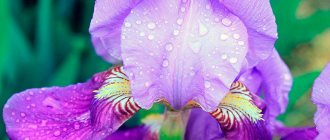More and more brides are trying to move away from classic wedding interpretations in order to express the features of their personality through accessories. A bouquet of bright, delicate and exquisite irises is what you need for this purpose. A huge number of shades, low cost and excellent compatibility with other plants make this flower an indispensable find for wedding floristry. Elegance and severity or romance and trepidation - irises will allow you to express both, the main thing is to correctly decide on the final composition.
Symbolism and meaning
During the times of ancient Babylon, delicate irises meant royal power, courage and courage of the military aristocracy.
In modern floristry, the interpretation has changed. Now a bouquet of irises in the hands of the bride symbolizes fidelity, strong friendship between spouses, endless mutual understanding and readiness to come to each other’s aid whenever the other half needs it.
When deciphering the meaning, the shade of the flower is taken into account:
- white traditionally speaks of purity and innocence, while yellow spots on the petals add joy to the interpretation;
- purple evokes deep, quiet loyalty;
- blue - about nobility;
- red - about passion;
- pink is about tenderness.
What kind of girls is it suitable for?
The flower is almost universal, and therefore will make a magical company for both a very young girl and an elegant adult woman.
The most common blue and purple buds are wonderfully suitable for creative people, those who look at the world around them with interest and notice beauty in everything.
Brighter shades will appeal to bright, bold girls, while snow-white and pastel shades will appeal to romantic dreamers.
Idea! Irises are a great choice for a themed wedding in a rustic, vintage, Provençal style.
The original inflorescences are suitable for a variety of dress styles and hairstyles. Unless lush ball gowns with a corset may require more sophistication from the bouquet - in this case, delicate irises should be supplemented with larger buds of roses, peonies or lilies.
Iridarium
There are flower beds, and even entire gardens, in which the described flowers occupy a dominant place. Such elements of landscape design are called iridariums. Designers like to plant groups of irises using two or three varieties of flowers. You need to select them wisely, using the most popular combinations.
Between such groups it is necessary to leave gaps. They will allow plants to grow correctly and acquire the correct shape. Irises are flowers to admire. Therefore, it is important to seat them in such a way that you can wander between separately planted groups and look down at them.
To make iridariums look even more impressive, open areas of soil need to be mulched - sprinkled with chopped tree bark or wood chips. It is better to draw examples of the correct formation of such decorative forms from the finished works of Japanese designers, who create amazing man-made landscapes in beauty that can compete with the work of nature itself.
Iridarium in a Japanese garden Source m.brecks.com
Advantages and disadvantages
Each flower has both its advantages and disadvantages, which should be taken into account when choosing a composition.
Pros of irises:
- presented in a huge palette of shades and shapes;
- goes well with any other plants;
- practically no smell, which is convenient for allergy sufferers;
- relatively budget-friendly;
- look gentle and feminine.
The disadvantages include the fact that irises:
- not very hardy, stems break easily, petals wrinkle and become deformed;
- They do not tolerate drought well, so place the flowers in a vase as soon as possible;
- short-lived: the bouquet will not last longer than three days after the celebration;
- seasonal - from August to February it is extremely difficult to get irises , and they will not be cheap at this time.
Proper care of irises
For the full development and appearance of flowers, the plant must be periodically watered with liquid fertilizers containing minerals: nitrogen, phosphorus and potassium. All fertilizers must be applied in three doses in equal parts.
The ideal time for the first feeding is the time when sprouts appear above the ground. The second fertilizing should be done about a month after the first application of fertilizers.
The second stage uses nitrogen, potassium and phosphorus. After the flowers bloom, a third fertilizing is applied only using potassium and phosphorus, without nitrogen.
During the growing season, the plant must receive at least 9 grams of nitrogen, potassium and phosphorus per square meter. An important nuance - all fertilizing must be applied in liquid form.
Types and colors
There are several hundred varieties of irises - with double or smooth petals, plain, spotted, striped. The palette is also extensive, and includes snow-white, pastel and bright shades, all the way to almost black.
Most often, white, purple or blue varieties are used for wedding bouquets , as they ideally match a white dress, complement or become a bright, charming accent.
Options
Even a mono composition of these spring flowers looks interesting for a wedding bouquet. If you choose colored, bright buds, then you don’t have to bother decorating the stem too much. All you have to do is wrap the fresh stems with matching ribbon.
Pastel or white compositions usually require more decor - fabric, paper or lace, which emphasize the romance of the bouquet.
Important! Too much decor - mesh, beads, rhinestones, a lot of drapery - usually does not look very appropriate, because iris buds themselves are very beautiful and original. If you still need decorations, then it is better to place them on other flowers. For example, transparent rhinestones will beautifully decorate lily petals.
The stems of irises are very fragile, and the flowers need constant replenishment with moisture. So the presence of a stem has an undeniable advantage - you can tape the stems by wrapping them in cotton wool with a special solution, and then hide additional devices behind decorations.
Delicate flowers also look good in a duet with sensual tulips, lush peonies, fragile daffodils, sunny chrysanthemums or royal lilies, roses, orchids.
Most often, a round bouquet or scepter is used, but if desired, you can make a luxurious cascade by adding more varied greenery.
White mono bouquet
A bouquet of white irises looks incredibly elegant, tender and romantic. The buds can be monochrome, fluffy, or smoother, with bright yellow splashes , which are perfectly complemented by other sunny flowers - mimosa, chrysanthemums, daffodils. A white and yellow bouquet is ideal for fall or winter weddings.
In their pure form, white irises will create a real sensation, and so that the composition does not get lost against the background of a white dress, choose slightly different shades or add large patterned fern leaves along the edges. It is also better to leave the stem free; long, fresh stems will emphasize the slenderness and tenderness of the bride.
With tulips
Tulips are a symbol of happiness and long-lasting relationships. This spring flower with smooth petals will provide excellent company to the exquisite irises. The wide palette of both plants allows you to create chic combinations: from delicate and vibrant white and pink to bright red, orange, and purple.
Advice! Tulips are very resilient plants that can withstand frost, heat and being thrown to girlfriends, but irises are not ready for such tests, so be careful with the bouquet, because even one wilted flower will ruin the overall picture.
A classic, elegant duet will be created by purple irises with yellow splashes and yellow tulips to match. At the same time, the leg can be decorated with colored ribbons, practically removing the greenery - this way the composition will turn out absolutely fabulous.
Any bright shades go well with white, creating a spring and joyful mood:
- red and white will tell about incredibly strong feelings, real passion;
- orange and white - about well-being and confidence in each other;
- adding green can be considered a wish for the speedy birth of children;
- blue - a symbol of a dream come true.
If desired, create a monochrome composition of irises and tulips - white, purple, pink or blue. This ensemble looks gorgeous. And if you choose a red monochrome, it doesn’t matter whether it’s scarlet or burgundy, then the image will turn out to be royally luxurious . This composition looks quite heavy, so it is necessary to balance it with other details of the image, for example, a shade of lipstick or matching shoes.
Blue bouquet with chrysanthemums
Fluffy, flirty chrysanthemums, a symbol of lightness and fidelity, perfectly emphasize the severity of iris petals. The classic blue and white version is most often used, because such a bouquet turns out incredibly delicate and becomes a wonderful accent.
You can use pink chrysanthemums - the overall picture will immediately become much more tender and vibrant, especially if the blue irises are replaced with soft blue ones. The reverse combination also looks good - white irises with blue or blue chrysanthemums.
Two plants, supported by climbing greenery, wonderfully form into cascades , but also look decent in a classic round shape.
An interesting idea would be to use different varieties of irises, for example, both blue and white, with a single contrasting or pastel chrysanthemum.
Monochrome is also acceptable - a completely blue bouquet looks unusual , allows you to demonstrate the bride’s impeccable taste and wonderfully emphasizes the snow-whiteness of the dress.
Of roses
The rose looks great with bright spring irises, and interesting compositions can be made from any variety - dwarf, large, fluffy or elegantly elongated roses.
Remember that roses are rather capricious plants that do not tolerate any proximity in a vase , so after the celebration the flowers will have to be separated. However, the wonderful appearance makes up for this annoying problem.
Roses, without a doubt, play a leading role in such ensembles. In this case, we allow both monochrome - completely white, blue, pink compositions, and bright inclusions. The combination of purple irises with spots and yellow or burgundy roses looks interesting. Classic - white or cream roses with blue or light blue irises. For brave brides, a completely blue-blue combination is possible.
The presence of roses lifts the ban on mesh , and if desired, the bouquet can be supplemented with this interesting accessory, as well as lace, rhinestones or beads, not only along the stem, but also on top.
How to land?
For rhizomatous varieties, the vegetative method of propagation is suitable. New shoots of the root system are used as planting material. To do this, the root system is divided into parts so that each contains leaves and rhizomes.
The leaves are cut by half, and the roots by a third. Everything is inspected, rotten and dry parts are removed. Using a solution of potassium permanganate, it is disinfected and dried.
Before planting, the soil must be loosened and all weeds removed. In the hole where the young plant will be planted, a small hill is made, on which the roots are placed and spread around. Be sure to water the young plant. Bulbous irises produce many new ones in 2-3 years near the parent bulb. The first shoots appear a year after planting.
Large bulbs are dug up, dried and left until autumn. Iris bulbs are also planted in pre-loosened soil, cleared of weeds. The bulbs are lowered into the prepared holes, very carefully so as not to damage the roots, and sprinkled with earth. Then water generously.
Florist recommendations
To make irises please you for as long as possible, follow simple rules:
- Try not to touch the buds during the holiday. Iris petals are fragile and easily crushed;
- Irises love water very much, so place the bouquet in a vase as soon as possible. In this case, you can add an aspirin tablet or sugar to the water;
- If a fresh green stem is not important to you, then tape the stems - wrap the ends in a special cotton wool with a solution, and cover the top tightly with a waterproof film. Next, you can decorate the leg in any convenient way;
- After the celebration, do not place irises together with lilies, orchids or roses , as all these flowers produce poisonous enzymes that shorten the life of irises. Be sure to separate the flowers and arrange them in several vases;
- Cut the stems diagonally with a sharp knife - you need to remove about 5 cm, then it will be more convenient for the flowers to drink moisture.
Important! Cut irises should not be exposed to direct sunlight or drafts.
Wintering
Iris rhizomes will survive a long and cold winter well, but the bulbs will have to be dug up and stored in dark, cool places where there is no access to moisture. They should not be placed in plastic bags or wrapped in rags.
If the bulbs cannot be dug up, they try to cover the planting site with covering material.
Magically colorful irises, planting and caring for them in the open ground will not take much time, will be a wonderful addition to any garden.
And photos of irises confirm this better than any words.
Photo
A wedding bouquet of irises will be an exquisite addition to the bride's image. It is suitable for themed and colorful celebrations and will look great in photos.











